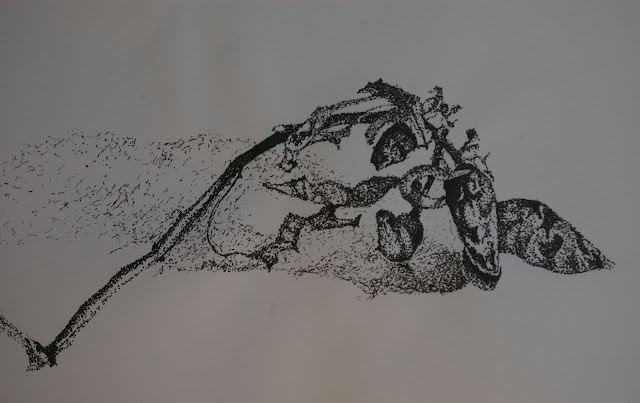Sketchy and Expressive: Frank Auerbach
Frank Auerbach is a good example of the fact that sketchy and expressive doesn't always mean rapid! Auerbach in his own way is just as rigorous in his execution as Celmins but his images have an altogether different quality. Below are links to some of his drawings. I am going to confine myself to his drawings in this research point rather than looking at his painting with his characteristic extremely thick paint application. My first impression on looking at some of his portraits (such as Jake 1990 - see link below) was that the form seems to emerge or that he somehow finds it from a series of scribbly seemingly random marks. This turns out to be not exactly true.
Frank Auerbach was was born in Germany to Jewish parents in 1931. Just before his eighth birthday his parents sent him to England. They were both killed during the war rendering Auerbach an orphan. (1)
Auerbach was taught by David Bomberg at evening classes at Borough Polytechnic in London and I think that Bomberg's influence can still be seen in Auerbach's work. Bomberg in turn had been influenced by the philosophy of seeing espoused by Bishop Berkley i.e " human beings only learn to connect sight to their experience of the physical world by a fairly long experimentation with touch and the other senses. On the back of the retina we get a reverse image, so that the newborn infant will reach up for something that is down and down for something that's up. It's only by crawling across the floor, touching things, judging distances haptically , by grasp and contact that it will relate the sight to the physical world" (2)
Bomberg's aim in teaching was more about the quality of form or 'the spirit in the mass' than about producing aesthetically pleasing pictures. he is quoted as saying " you're more likely to get it right when you're least self conscious, when you have given up any hope of producing an acceptable image- because then you're permeated wordlessly by the influence of the thing you're painting "(2)
Auerbach went on to study at St Martin's School of art and then at the Royal College of Art. In 1954 he started renting a studio in North London where he has worked obsessively ever since. He is reputed to work 364 days a week and an average of 10 hours a day. He will often work for a whole day on a painting only to scrape all of the paint off to restart. He must use vast quantities of paint!. He also re-iterates the same subjects over and over again. Landscapes in the immediate vicinity of his studio and portraits of favoured models who are painted over and over again (EOW, JYM and Julia- his wife). If you click on the link to Frank Auerbach at Marlborough Fine Art it illustrates this with numerous drawings of the same view of 'next door'. In addition on the 'Head of EOW 1959-60' linked to above you will notice a patch of paper has been added to the drawing. This again is because of Auerbach's tendency to rework over and over again the same piece. When working with charcoal he rubs the surface back to a grey shade than starts to redraw and erase again on top. Consequently the paper can wear through leading to holes and needs to be patched. In Robert Hughes' Biography of Auerbach this process is illustrated in a drawing in progress for Portrait of Sandra 1973-74. The portrait is the result of 41 sessions and a photograph was taken at the and of each session. Each time the portrait has been erased and redone and it alters radically. The author says that the final result doesn't look any more like the subject (Sandra Kitaj) than many of the others which were obliterated but ' it has a density that comes from exhausting most of the other alternatives'. Auerbach himself says, "I can do something that looks like one of my drawings in half an hour- but I find it unsatisfactory; it never seems specific enough for me to be new enough. So I find myself going on....and as I go on I find the problem more and more impossible , and because, I suppose of my temperament I find myself behaving in an excessive way in order to solve the problem"(2)
Auerbach is certainly single-minded and has therefore frequently found himself out of step with fashion - this was certainly the case in the '60s when his paintings were in no way related to the superficiality and glitz of pop art.
In an interview last year Auerbach summed up his approach" The only way which I could, with luck make a tiny contribution to art was to just simply work as hard and as much as I possibly could. I was always aware that I was very,very slow and that if a painting came together, or seemed to me to be satisfactory and not in any sense manufactured it would always have happened unexpectedly, at any time without me being able to foresee when" (3)
The looking retrospectively at his work at the age of 81 " I'm not self- analytical , however looking at the paintings now, it seems to me, that one could say, although if I were a curator or art historian I would never have the cheek- " a more dynamic way of drawing was searched for nu Mr Auerbach so he used a restricted palette so he could concentrate on that.' (3)
His drawing style is certainly dynamic in a way that belies the hours and hours of arduous repetition that goes in to it.
References:
(1)Hawksley, L : Frank Auerbach in 50 British Artists You Should Know. Prestel 2011
(2) Hughes, R : Frank Auerbach. Thames and Hudson 1990
(3)C, Lampert: Frank Auerbach in his own words. Telegraph 4th November 2012





















